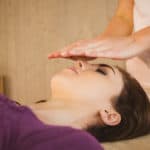 Want to earn continuing education credit for this article? Learn more.
Want to earn continuing education credit for this article? Learn more.
In the healthcare profession, hand washing is essential to stop the spread of potentially serious infections. To prevent transmitting pathogens, massage therapists are constantly washing their hands – before a client, after a client, before eating, after eating and after going to the bathroom. For a therapist who sees eight clients in a row, that can add up to over 20 hand washings during one day at work! While this habitual cleansing is mandatory for a healthy environment, it can also result in dry, chapped hands – which can eventually progress to dermatitis. To prevent the spread of germs and maintain healthy skin, bodyworkers have to pay extra attention to the condition of their primary diagnostic and treatment tool: their hands.
Skin 101
The largest organ of the human body, our skin protects us from our environment. With an outermost epidermal layer only 1/250th of an inch, and the dermis being only 1/50th to 3/25ths of an inch thick, the skin’s protective function can be interrupted without difficulty. Repeated hand washing easily leads to drying of the skin and microscopic cracks.
Since healthy skin has a slightly acidic pH, exposure to alkaline substances (such as many commercial cleansers and hand soaps) contributes to a disruption in the skin’s integrity. While a homeostatic repair mechanism repairs the skin’s barrier, continued exposure to alkaline substances will slow down this repair by inhibiting normal skin acidity. Used in most soaps, sodium lauryl sulfate is a foaming agent naturally derived from coconut and/or palm kernel oil. In its concentrated raw form, it has an approximate pH of 10, which is very alkaline and drying to the skin.
Once the top layer of the skin cracks due to recurrent wet/dry cycles, especially in conditions of low humidity where drying occurs rapidly, it results in inflammation. This is how irritant hand dermatitis begins. The swollen, reddened and itchy skin characterized by dermatitis is familiar to many frequent hand washers.
Dermatitis
Affecting all types of healthcare workers, dry skin and dermatitis are two conditions linked to frequent hand washing. In fact, the National Institute for Occupational Safety & Health (NIOSH) states that skin injuries and diseases account for a large proportion of all occupational injuries and diseases. A recent study conducted in collaboration with NIOSH and the American Academy of Dermatology focused on 100 healthcare workers in Cleveland who washed their hands at least eight times daily. Participants completed questionnaires identifying the frequency of hand washing, family history of dermatitis and medical condition history. Researchers used patch tests to determine how easily detergents irritated the participants’ skin and to predict which patients were at risk for hand dermatitis.
According to Susan T. Nedorost, dermatologist and associate professor of dermatology at University Hospitals Case Medical Center in Cleveland, “Our findings confirm that healthcare workers who wash their hands repeatedly are at an increased risk of developing hand dermatitis, which can take months to heal. This knowledge can help workers at risk for the condition to practice good hand care and follow preventative tips to decrease their risk factors on the job.”
Of particular interest, analysis of the data highlighted that the most important factor in predicting those at risk for hand dermatitis was a reaction to the detergent sodium lauryl sulfate (SLS). Specifically, the large percentage of participants who reacted positively to SLS and developed hand dermatitis far outweighed the number of participants who did not react positively to SLS, but subsequently developed hand dermatitis. Considering the highly alkaline pH of SLS, it’s not surprising that it was associated with dermatitis in this study.
5 Solutions
Since repeated hand washing is required for massage therapists, taking good care of their hands is very important. Suggestions for preventing the damage to the skin typically inflicted by frequent hand washing include:
- Choose your skin cleanser carefully. Make sure to use a pH-balanced skin cleanser and, if sensitive to SLS, use hand cleaners free of this foaming agent.
- Especially important if not working with oils or lotions during a session, make sure to moisturize after every hand washing. Moisturizers coat the skin with oil, block evaporation of the skin’s natural moisture and trap water in its surface. While they can’t cure dry skin, moisturizers provide protection, relieve the dry, itchy feeling and reduce the tendency to crack. Although most of the water in the cream or moisturizer evaporates, the oil stays on as a lubricant, enabling the skin to retain moisture. In addition, apply a good hand cream every night before bed.
- Give your hands a weekly paraffin treatment to help them recover from all of the hand washing. Paraffin is soothing to the skin because the wax is mixed with mineral oil. The heated seal that the wax creates allows the oil to penetrate the skin deeply for moisture restoration.
- When not at work, protect hands from further damage. Minimize direct exposure to cold, dry weather by wearing gloves when submersed in these elements.
- Maintain moisture inside and outside your body by drinking plenty of water and using a humidifier if the air in your home is dry.
As the single most important step towards infection control, healthcare professionals must wash their hands frequently. As such, massage therapists often encounter the consequences of washing their hands ten times a day or more. Make sure to pay extra attention to your hands’ moisture and periodically pamper your mitts. By making good hand health a priority, even bodyworkers can avoid dry, cracked, itchy and irritated hands.
Earn continuing education credit for this article contained in our Skin Pathologies series. Click here to enroll.















